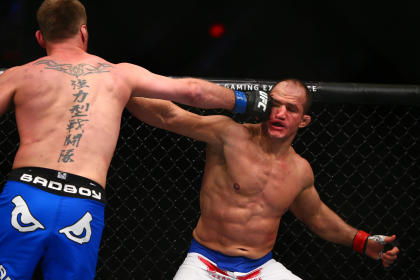Study: Increased blows to head linked to smaller brain volume
LAS VEGAS – Nearly four years into a landmark Professional Fighter Brain Health Study being led by neurologist Charles Bernick, research has discovered that repeated blows to the head are linked to smaller brain structure volume and slower processing speed.
Researchers have developed a formula they've dubbed the Fight Exposure Score (FES) that essentially assists doctors in evaluating a fighter's risk of developing cognitive impairment as he or she continues to fight.
The study, being conducted at the Cleveland Clinic Lou Ruvo Center for Brain Health in Las Vegas and soon to expand to the clinic's main campus in Cleveland, has nearly 500 participants. That includes currently active and retired boxers and mixed martial arts fighters, as well as a control group.
The athletes were given an MRI scan and were tested for verbal memory, processing speed, fine motor skills and reaction time. The MRI was used to assess the volume of particular areas of the brain, particularly the thalamus and the caudate nucleus.
Some of the athletes have come back to repeat the test multiple times.
The initial results show a correlation between slower processing speeds and smaller brain structure volume with being punched in the head. However, it hasn't been determined whether A) the smaller volume and slower processing time is because of shrinkage related to the head trauma or B) if those born with smaller volume and with slower processing times are at greater risk.
"The study can only look at relationships and we don't know cause and effect," said Bernick, who published a paper detailing his preliminary findings Thursday in the British Journal of Sports Medicine. "Our interpretation is … because more exposure to head trauma is associated with lower volumes of these structures, we are hypothesizing that … repeated head trauma causes either direct damage to these areas or causes injury to fibers that connect to these structures thus, causing shrinkage."
Bernick said that at this point, boxers appear to be at greater risk of cognitive problems and brain shrinkage than mixed martial arts fighters.
The reason for that, Bernick said, isn't so simple to determine at this stage.

"Boxers come out worse," he said. "We're seeing more shrinkage in boxers in these particular structures we're looking at on the MRI. What does that mean? Does it mean that boxers are sustaining more trauma or are boxers just different in general? A lot more MMA guys are college educated. They come, in a lot of cases, from different socio-economic backgrounds than the boxers.
"We can't pinpoint the cause for this, though just off the top of your head you'd say, 'Yeah, it's because [boxers] get hit in the head more.' If you look at these statistics services like CompuBox and [CompuStrike], it's clear that boxers are being hit more than MMA guys in the same weight classes. So is the answer simply, 'They get hit more?' Whether that's the only factor, though, I don't know. But yes, boxers come out worse [than MMA fighters]."
Bernick is excited that the clinic's main campus in Cleveland is joining the study. The Cleveland Clinic has a 7 Tesla magnet on its MRI scanner which is more than twice as powerful as the 3 Tesla magnet on the MRI scanner in Las Vegas. That will enable researchers to get a closer and more precise look at structures in the brain.
"Given that we're going to get a much more precise view of these structures, these brain structures and the connections between the different areas of the brain, that we think we will be able to hone down and get a better understanding of the type of injury that occurs with head trauma and how it changes over time," Bernick said. "That's a huge tool to be able to use."
In addition, scientists in Cleveland have developed what is called an "intelligent mouth guard," that can determine more precisely than sensors the amount of force being placed upon the brain when it is struck.
